|

by A Midwestern Doctor
October 11, 2024
from
Mercola Website
PDF Version
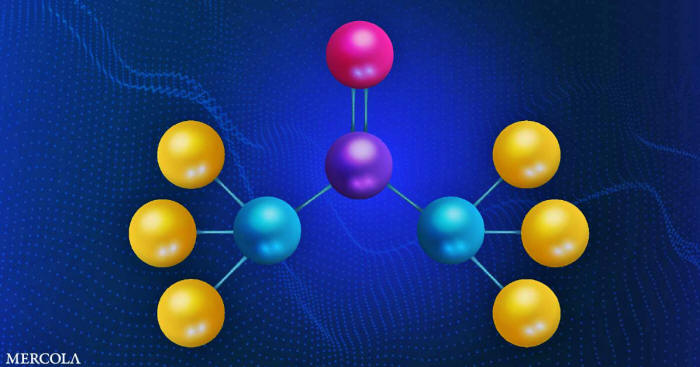
Story
at-a-glance
-
DMSO is
a remarkably safe chemical that protects cells from
otherwise fatal stressors (e.g., freezing, burning,
shockwaves, ischemia)
-
Since
the heart, brain, and spinal cord are particularly
vulnerable to injury, DMSO can produce miraculous results
when those injuries happen
-
Despite
decades of research, many serious shortcomings exist with
how we treat strokes (including brain bleeds), heart
attacks, and spinal cord injuries
-
As I
will show here, had the FDA not sabotaged DMSO's adoption,
in addition to countless lives being saved, millions could
have been protected from a lifetime of disability or
paralysis
If I were stranded on a desert island or knew the world was ending
and I could only bring a few therapies with me, one of them, without
a doubt, would be DMSO.
This is because:
-
It effectively addresses acute injuries
(e.g., sprains) and chronic musculoskeletal disorders (e.g.,
arthritis).
-
It's one of the most effective pain
killers in existence.
-
It treats severe, often incurable
illnesses and prevents long-term disability.
-
It's one of the safest medically active
substances available.
Yet, despite it taking the world by storm in the
1960s and thousands of studies being performed that corroborated its
benefits, outside of it being a laboratory chemical or an
alternative therapy some people use for joint pain, few are even
aware of DMSO's existence.
This was due to
the FDA
waging a multi-decade long war against DMSO
(despite widespread outcry from Congress and the public).
What Is DMSO?
Dimethyl Sulfoxide (DMSO) exists throughout nature
1 and has two
breakdown products within the body.
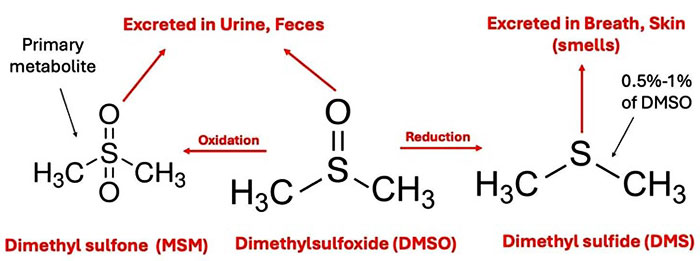
-
Most of it is oxidized to methylsulfonylmethane (MSM
- a commonly
used joint healing supplement)
-
While a small amount is reduced to DMS and gives rise to DMSO's characteristic "side effect",
...a
distinctive garlic or clam-like odor that is excreted through the
mouth and skin for a few hours that some individuals have difficulty
tolerating.
Note:
Individuals with insufficient oxidation (who are in a state of
reductive stress) are more likely to produce DMS. In turn, when this
is addressed, their "DMSO odor" often disappears.
Due to its unique chemistry, DMSO has two remarkable properties:
-
It acts as a near-universal solvent (e.g., it interacts with a vast
range of biomolecules). 2,3
-
It's able to pass through biological membranes without damaging them
(something to my knowledge, nothing else can do). 4
Because of this, DMSO will rapidly enter the body (including the
brain) regardless of its route of administration (e.g., within 5
minutes after going on the skin it can be found in the blood, 5 and
within an hour it can be found within the bones), 6 but
simultaneously does not accumulate within the body. 7
DMSO, in turn, has an almost endless number of uses as it can be
applied in almost any manner.
Almost any drug or substance can be
combined with it and administered through the skin (e.g., steroids, NSAIDs, vitamin C, or hydrogen peroxide).
In many cases, the effect
of those drugs is enhanced, and simultaneously, their toxicity is
reduced (although, in some cases, the toxicity increases).
Cellular Protection
DMSO's ability to spread throughout the body (including into the
brain) initially seems concerning - however rather than be toxic to
cells, DMSO heals them and protects them from damage from many
otherwise lethal stressors (e.g., heat, blood loss, radiation, sonic
shockwaves).
For example, since DMSO does not expand when it freezes and greatly
lowers the freezing point of cells, it was a revolutionary substance
for preserving frozen cells, 8 and likewise, many cases exist of DMSO
saving the fingers or toes that otherwise would have required
amputation.
Note:
Due to the intense scrutiny DMSO received, thousands of papers
have been published on its biological effects (including numerous
animal safety studies and one where humans were exposed to 3 to 30
times the typical dose for 90 days) 9 - all of which did not report
any significant side effects from DMSO.
In turn, those studies found the most common side effect (affecting
50% to 75% of users) is (reversible) irritation at the site when 70%
DMSO is applied topically on the skin (which can be easily
mitigated) and the most significant was an allergic reaction in
approximately 1 out of every 2000 people (which can easily be
screened for).
Circulatory Disorders
DMSO is remarkably effective in managing circulatory disorders,
effectively protecting tissues and enhancing blood flow by removing
excess fluid, improving circulation, and dissolving clots.
Its
benefits are particularly evident in conditions like Raynaud's
syndrome, where it eliminated symptoms in 50% of patients, 10 and in
diabetic circulatory issues, with studies showing over a 94%
success 11 rate in treating diabetic ulcers.
DMSO also works wonders for varicose veins, often providing
noticeable improvements within minutes by strengthening vessel walls
and enhancing capillary circulation.
In a study of 67 patients with
varicose ulcers, 12 remarkable responses were documented, even in
chronic cases. Additionally, DMSO has been shown to help many other
circulatory disorders: 13,14
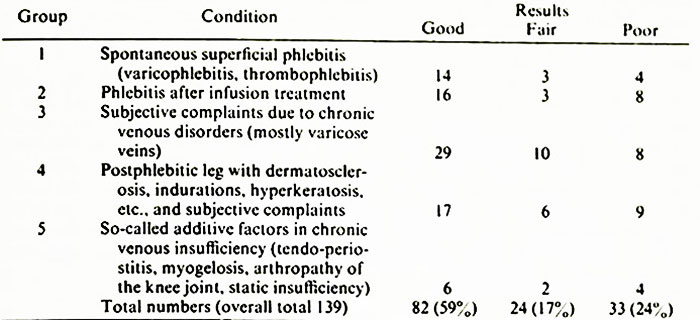

Key mechanisms behind DMSO's effectiveness include:
• Heart function - It can increase or decrease heart contractions
without affecting rhythm, enhancing cardiac output and
simultaneously dilates critical blood vessels.15
• Anticlotting properties - DMSO prevents blood clot formation in
the body, reduces clot promoting prostaglandins, and is a powerful
platelet deaggregator.16,17,18
Its ability to safely block platelet
bonding, scavenge harmful radicals, and inhibit tissue factor
expression makes DMSO a standout in circulatory health. 19
Heart Attacks
cardiac actions
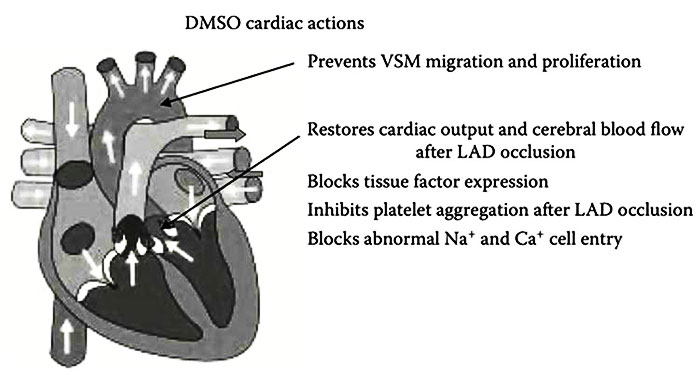
Given all of these protective and circulatory enhancing properties,
DMSO is an immensely promising treatment for heart attacks and heart
attack recovery, 20 and this benefit has been demonstrated in
numerous animal studies. 21,22
Likewise, I and colleagues have had a
few situations arise where DMSO was administered to someone having a
heart attack and successfully treated it.
Note:
We've also had some success treating heart attacks by rapidly
restoring someone's physiologic zeta potential.
DMSO
and Strokes
Roughly 3.1% of adult Americans have experienced
a stroke 23
(a figure we expect to rise from the COVID-19 vaccines).
Each year,
this translates to about 800,000 people in the United States having
a stroke, in 2022, 165,393 dying and between 20% to 40% of survivors
experiencing long term disability. 24
Because of the harm strokes pose to society, and
the rate at which brain tissue deteriorates once its blood supply is
lost, the medical system prioritizes treating strokes as soon as
possible.
Strokes come in two main types: ischemic (caused
by clots blocking blood flow) and hemorrhagic (due to ruptured blood
vessels).
The standard treatment for ischemic strokes is tPA, 25
a clot-busting drug. However, administering tPA can be deadly if the
stroke is hemorrhagic, so patients must first wait for a CT scan
before receiving it.
Furthermore, tPA is only effective within a
limited time frame (up to 3 to 4.5 hours 26),
and only a small percentage of patients (1.8% to 8.5%) actually
receive it.
Among those who do, only 13% 27
see significant improvement.
Additionally, tPA can cause serious
bleeding complications 28
(e.g., 6.4% risk 29
of a symptomatic brain bleed) and can't eliminate larger clots.
In short, strokes remain a leading cause of death
and disability worldwide.30
This highlights the need for a better treatment that can safely:
|
Effectively treat ischemic strokes |
Has no risk of worsening a
hemorrhagic stroke |
|
Could easily be taken at home, and
more importantly, be quickly given on ambulances |
Protected brain tissue from dying |
|
Prevented reperfusion injuries |
Healed damaged brain tissue after a
stroke |
DMSO has been known for over 50 years to do just
that.
For example, a 2002 trial with DMSO combined with fructose
diphosphate (FDP - a source of cellular energy) indicated that 63%
of elderly patients experienced improved neurological status when
treated within 12 hours of a stroke, compared to only 20% with
standard care. 31
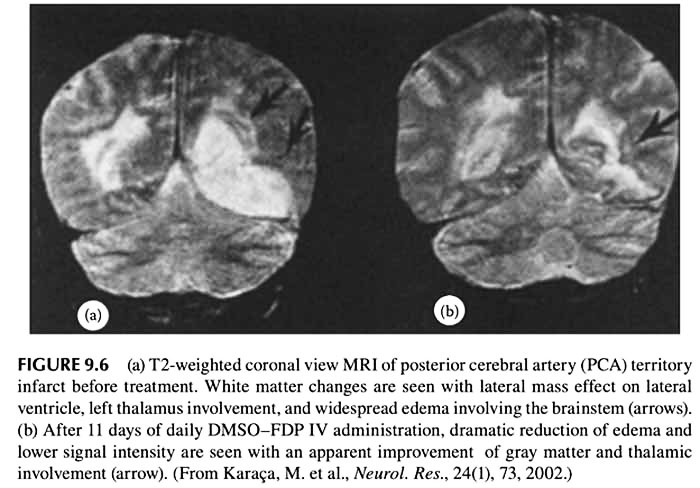
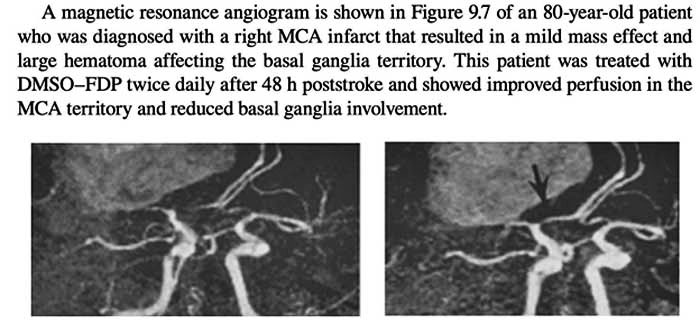
One of the most
important aspects of this trial was that while DMSO is the most
helpful when given immediately after a stroke, the trial showed DMSO
could save the neurons long after the stroke had happened.32
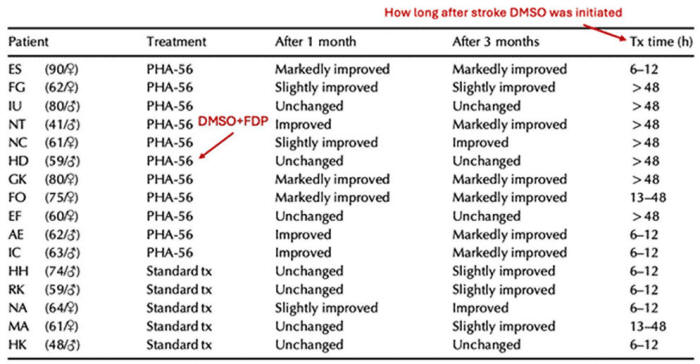
Given the existing options for strokes, a trial
like this should have been immediately replicated by premier
institutions around the world - but instead almost no one even knows
it happened.
Note:
Numerous animal studies (listed
here) have also demonstrated DMSO's effectiveness in treating
ischemic strokes. Sadly this revolutionary medical treatment remains
a forgotten side of medicine.
After I learned how unconscionable
the FDA's
prohibition against DMSO was, I made a point to begin telling people
I felt were at risk of a stroke to stock DMSO at home, and since
then, I've had instances where someone (or their caretaker) called
me up, described a stroke, I gave them instructions on what to do
(since they already had DMSO at home), and by the time they got to
the ER, the stroke was "resolved."
Note:
In my opinion, IV DMSO would have been ideal (and more effective) in
those situations, but in each case, it was not feasible to
implement.
Likewise, many compelling cases have been
recorded33
of individuals who treated their strokes with DMSO:
"A Los Angeles
school teacher suffered a major stroke just after Christmas,
found unconscious at home.
Immediately, she was treated with DMSO: first applied topically to her head and then given by
intramuscular injection - all without ever going to the
hospital, thanks to a family friend's advice.
Remarkably,
she regained consciousness later that day and continued daily
DMSO treatments.
By the time school resumed in January, she was
back teaching, fully recovered and without any mention of her
ordeal. She continued her teaching career until retirement,
healthy and free of disability."
In another case, a woman in a coma for three
months after a stroke showed no signs of life.
Daily topical DMSO
treatment was started, and within a month, her brain began to
respond. After four months, she returned home and began a regimen of
daily DMSO in water alongside topical applications.
Three years
later, she was living a normal life with only a slight speech
defect, claiming her memory was sharper than her husband's.
Note:
There are also many reported cases of individuals who took DMSO for
musculoskeletal or pain disorders (by far the most common use of
DMSO) who then experienced a permanent improvement of stroke
symptoms.
Hemorrhagic Strokes and
Traumatic Brain Injuries
While ischemic strokes are difficult to treat,
hemorrhagic ones (and other traumatic brain injuries) are even more
challenging, and after decades, there has been surprisingly little
progress in neurologic intensive care, particularly in preventing
long-term paralysis and disability. 34
"It was, as if
the hand of God had somehow touched the [experimental] animal's
forehead. ‘I don't believe it,' I stammered.
But it was true. I
felt a tingling in my spine because this reawakening of a
virtually dead animal had all the markings of a medical
breakthrough.
Instead, the
discovery, the potential for saving lives and the continued
research that should have uncovered other uses for dimethyl
sulfoxide and similar agents was quietly laid to rest in the
coffers of forgotten medicine."
Note:
Dr. Jack de la Torre's observations were partly based on the fact he
saw numerous animals with flatlined EEGs (which typically precede
brain death and then actual death) have the EEGs come back within 10
minutes of receiving DMSO.
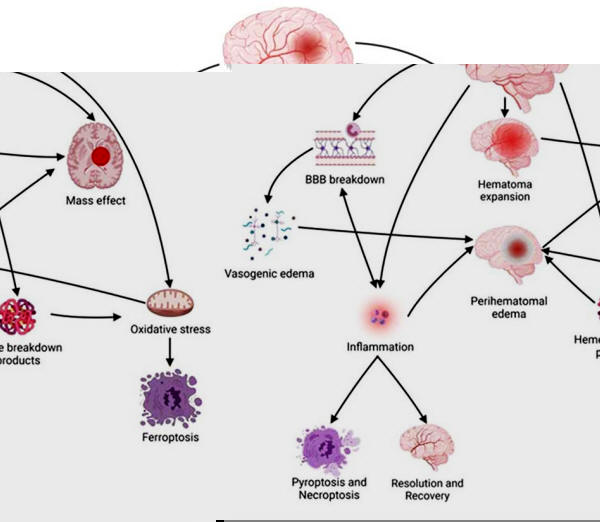
In cases of severe brain bleeds, key challenges
like increased intracranial pressure (ICP) and inflammation can
severely damage brain tissue.
Common treatments often fail, leading
to further complications (e.g., the most commonly used ICP lowering
agents like mannitol can create a "rebound ICP" which is higher than
it was at the start).
Remarkably, DMSO 35
effectively lowers ICP 36
without the rebound effect seen with other agents, while enhancing
cerebral blood flow and reducing inflammation.
Research shows DMSO can significantly improve
outcomes in traumatic brain injuries. In several studies, patients
with elevated ICP experienced rapid decreases in pressure and
improved neurological function after DMSO treatment.
For instance,
one study demonstrated a drop in ICP within 30 minutes for patients
with closed head trauma, leading to long-term neurological
improvement. 37
Additionally, DMSO also
addresses many other critical aspects of traumatic brain injuries
and brain bleeds (which under conventional care requires many
different drugs):
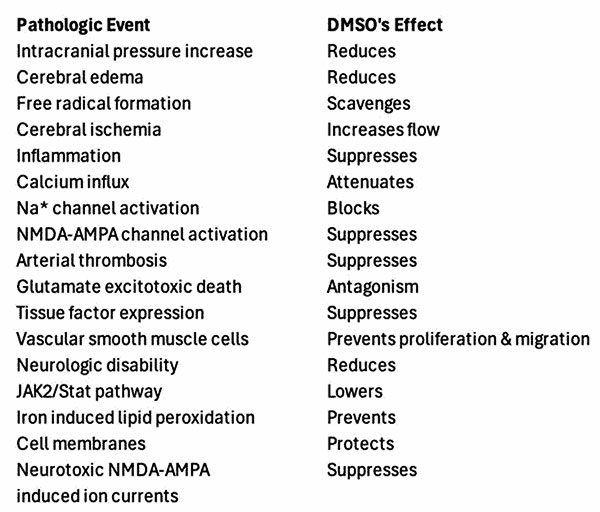
Animal studies further support these findings,
showing DMSO's ability to reduce brain swelling and
improve survival rates in models of brain injury. Its unique
properties make it a standout option in neurocritical care,
addressing multiple challenges associated with brain injuries. 38
To put all of this into context:
"A January 11,
1981,
a news report 39
in the Ocala Star Banner [page 6], carried the headline:
'DOCTOR
CLAIMS DMSO SAVED 11.'
The story read:
SAN DIEGO (AP)
A doctor at the University of San Diego credits the
controversial drug DMSO with saving the lives of 11 people who
suffered severe head injuries.
Dr. Perry E. Camp, a UCSD Medical
School neurosurgeon, said Friday that dimethyl sulfoxide was
effective for 11 of 30 people judged near death and for which
other lifesaving methods have proved useless.
'To take
patients like that and have even one out of 10 survive is
phenomenal,' Camp said. 'The fact that we have any survivorship
at all ... doesn't sound like much, but it is extremely
encouraging,' Camp said."
Sadly, however, despite the immense amount of
research conducted and these results being dramatically better than
what the standard of care can offer, this remains an almost
completely forgotten side of medicine.
Note:
Many of the same principles hold true for concussions, and the
pioneers of DMSO felt it was an essential treatment for athletes
after they experienced one - particularly since unhealed concussions
can predispose the athlete to long-term cognitive issues (e.g., both
boxers and professional football players have a threefold risk of
dementia). 40,41
Spinal Cord Injuries
"We used to
think that the damage caused at the moment of injury in a severe
head or spinal cord injury was irreversible.
But now there are
animal studies and a handful of clinical cases that tell us
something different. There is still a little bit of time before
the injured cells die.
Based on what
we've seen in animal studies and a handful of human situations,
we think that if you can treat a head injury victim within a few
hours of the injury, or a spinal cord victim within one hour,
there is a good chance of preventing death or the paralysis that
would otherwise occur."
Dr. Jack de la Torre
As much of the same pathology that causes
permanent damage in the brain also occurs in the spinal cord (the
loss of blood flow and compressive post-traumatic swelling), DMSO
can produce miraculous results. 42
Despite decades of research, steroids remain the standard treatment,
even though they're
largely ineffective and come with significant side effects. 43
In fact, spinal surgeons often use steroids simply to avoid
lawsuits. 44
The greatest success comes when DMSO is
administered intravenously within 90 minutes of injury.45
For example, dogs that were expected to be paralyzed after spinal
cord trauma regained nearly normal function after DMSO treatment.
Numerous other animal studies have also shown 46
DMSO prevents spinal cord injuries from causing paralysis, and
in humans numerous miraculous stories exist, such as a
16-year-old quadriplegic girl gradually regained organ function and
eventually walked after a year of DMSO therapy.
Even older injuries
see results - one man, paralyzed for 12 years, regained some feeling
and movement after using a DMSO lotion.
Cognitive Impairment and
Dementia
Since many neurological disorders are linked to
poor blood flow to the brain, previous traumas (e.g., concussions or
microstrokes), the accumulation of misfolded proteins or an
autoimmune process (all things
DMSO is also remarkably effective at treating), it stands to
reason that many cognitive disorders would respond to DMSO.
In turn, we find that much in the same way DMSO
reverses many other complications of aging (e.g., skin issue, hair
loss, poor organ function) IV DMSO is one of the most effective
antiaging therapies for the brain (along with
ultraviolet blood irradiation or
improving the physiologic zeta potential).
Likewise, IV DMSO is one of the only therapies I
know of which can help challenging neurological diseases like
Multiple Sclerosis, Parkinson's and ALS.
Likewise, I periodically
come across anecdotes of DMSO consuming centenarians who have no
cognitive impairment despite their age.
Numerous animal and human studies demonstrate this.
For example:
-
18 patients
with probable Alzheimer's disease47
were treated with DMSO and tested regularly for nine months,
with great improvements being noted after only three months of
treatment, and becoming especially noticeable after six months
of treatment.
Areas of improvement included memory,
concentration, and communication alongside a significant
decrease of disorientation in time and space.
-
100 patients
with cerebrovascular diseases48
(e.g., a previous stroke, cerebral embolism, or a hardening of
the arteries of the brain), many of whom were senile received
DMSO orally and through intramuscular injections over the course
of 50 days.
In addition to their coronary heart disease (i.e.,
atherosclerosis) and high blood pressure improving in 96.12% of
them, the observing neurologist noted that their cognition, mood
and behavior improved.
-
A study of49
104 elderly adults with a disease process causing impaired
cognition found DMSO was highly favorable for both their
cognitive and psychiatric function.
Note:
Since many psychiatric conditions are neurological in nature, DMSO
has also been shown to be remarkably effectively here (e.g., a study50
found it had a 100% success rate in treating acute schizophrenia,
and an excellent effect on psychosis from manic-depression or
alcoholism, chronic schizophrenia, anxiety and obsessive compulsive
disorder).
Conclusion
DMSO was discovered during a time when the
scientific community was open to exploring unconventional ideas, as
science had not yet been handcuffed
by a grant system designed to thwart unconventional ideas.
In
turn, thousands of studies were published on its potential, thanks
to dedicated researchers with strong institutional support.
However, despite this promising research, the FDA
suppressed its development, consigning years of scientific effort
and countless animal sacrifices to the dustbin of history.
This is particularly tragic given the immense
suffering caused by conditions that DMSO could potentially
alleviate. Decades of research and billions of dollars later,
conventional medicine still struggles to treat many of these
disorders effectively.
Dr. Pierre Kory, after reviewing this
article, shared my sentiments:
"In over 15
years of running ICUs and treating brain injuries, strokes, and
bleeds, it saddens and infuriates me to know an intervention
like DMSO could've helped so many.
The treatments I relied on
were often limited or came with major risks."
My goal in presenting this work is to give DMSO
another chance to flourish and help those in need. I sincerely thank
you for your attention and allowing me to do this!
Author's
note:
This is an abridged version of
a longer article about the remarkable utility of DMSO which goes
into greater detail on the points mentioned here (e.g., stroke
recovery and spinal cord paralysis or how DMSO protects tissues from
a variety of stressors), others not covered (e.g., the wealth of
evidence DMSO can treat immensely challenging conditions like
amyloidosis and Down Syndrome), and the protocols for internal DMSO
use.
That article and
its additional references can be read
here (along with
a companion article discussing DMSO's remarkable utility for a
variety of musculoskeletal injuries and chronic pain conditions).
A Note from Dr. Mercola
About the Author
A Midwestern Doctor (AMD) is a board-certified
physician from the Midwest and a longtime reader of Mercola.com.
I
appreciate AMD's exceptional insight on a wide range of topics and
am grateful to share it. I also respect AMD's desire to remain
anonymous since AMD is still on the front lines treating patients.
To find more of AMD's work, be sure to check out
The Forgotten Side of Medicine on Substack.
Sources and
References
1 Nature.
1963 Nov 30:200:885. doi: 10.1038/200885a0
2 Biosci
Rep. 1994 Dec;14(6):259-81. doi: 10.1007/BF01199051
3, 4, 5 Ann
N Y Acad Sci. 1975 Jan 27:243:20-3. doi:
10.1111/j.1749-6632.1975.tb25340.x
6 Annals
of NYAOS, March 1967, Volume 141, Issue 1, Pages 85-95
7 J
Clin Oncol. 1998 Feb;16(2):610-5. doi:
10.1200/JCO.1998.16.2.610
8 Cryobiology.
1987 Feb;24(1):11-6. doi: 10.1016/0011-2240(87)90003-4
9 The
Human Toxicology of Dimethyl Sulfoxide, August 25, 2011
(Archived)
10 DMSO,
The True Story of a Remarkable Pain-Killing Drug, January
1981 (Archived)
11 Ann
N Y Acad Sci. 1975 Jan 27:243:408-11. doi:
10.1111/j.1749-6632.1975.tb25383.x
12 Ann
N Y Acad Sci. 1975 Jan 27:243:395-402. doi:
10.1111/j.1749-6632.1975.tb25381.x
13 Ann
N Y Acad Sci. 1975 Jan 27:243:403-7. doi:
10.1111/j.1749-6632.1975.tb25382.x
14 Annals
of NYAOS, March 1967, Volume 141, Issue 1, Pages 586-598
15, 16 Ann
N Y Acad Sci. 1975 Jan 27:243:110-21. doi:
10.1111/j.1749-6632.1975.tb25350.x
17, 19, 46 The
Forgotten Side of Medicine, September 16, 2024
18 Prostaglandins.
1976 Apr;11(4):599-607. doi: 10.1016/0090-6980(76)90063-0
20, 35 Pharmacological
Reports, 2009, 61, Pages 225-235 (Archived)
21 J
Cardiovasc Pharmacol. 2010 Jan;55(1):106-9. doi:
10.1097/FJC.0b013e3181c87a65
22 Amazon,
The Persecuted Drug: The Story of DMSO
23 CDC,
Cerebrovascular Disease or Stroke
24 Brain
Neurorehabil. 2022 Mar; 15(1): e5
25 NINDS,
Tissue Plasminogen Activator for Acute Ischemic Stroke (Alteplase,
Activase®)
26 Stroke,
Volume 40, Number 6, doi: 10.1161/STROKEAHA.108.544171
27 Arch
Neurol. 2008;65(11):1429-1433. doi:
10.1001/archneur.65.11.1429
28, 29 Neurohospitalist.
2011 Jul; 1(3): 138–147
30 Journal
of the American Heart Association, Volume 11, Number 21, doi:
10.1161/JAHA.122.027044
31 Neurol
Res 2002; 24: 73-80
32 Neurol
Res. 2002 Jan;24(1):73-80. doi: 10.1179/016164102101199567
33 Amazon,
The DMSO Handbook for Doctors
34 Ciba
Found Symp. 1975:(34):3-21. doi: 10.1002/9780470720165.ch2
36 Neurosurgery.
1981 Jul;9(1):28-33. doi: 10.1227/00006123-198107000-00005
37 Eur
J Clin Pharmacol. 1991;40(1):113-4. doi: 10.1007/BF00315149
38 J
Neurosurg. 1980 Jul;53(1):58-62. doi:
10.3171/jns.1980.53.1.0058
39 Google
News, Ocala Star Banner, January 11, 1981
40, 41 eClinicalMedicine.
2023 Jul; 61: 102056
42 Surg
Neurol. 1973 Jan;1(1):16-22
43 Korean
J Neurotrauma. 2022 Apr; 18(1): 22–30
44 Can
J Neurol Sci. 2008 Mar;35(1):41-5. doi:
10.1017/s031716710000754x
45 Amazon,
Dimethyl Sulfoxide (DMSO) in Trauma and Disease
47 Medical
University, Kisheinev
48 Rev.
Hosp. San Fco. De Borja, 1970
49 Rev.
Hosp. Psiquiátrico (Santiago), 1970
50 Ann
N Y Acad Sci. 1967 Mar 15;141(1):655-67
|











